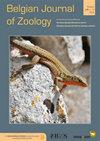许多食肉动物以草和其他纤维状植物组织为食
IF 1.1
4区 生物学
Q2 ZOOLOGY
引用次数: 3
摘要
在食肉目中,纤维状植物组织(FPT)的消耗,如叶子和茎,仅能满足Ailuridae和Ursidae中八个物种的营养需求。除了Ailuridae和Ursidae,人们对食肉动物摄入FPT的程度知之甚少。进行了文献检索,以汇编包含食肉动物食用FPT证据的研究,主要基于对粪便或胃肠道的分析。在352项研究中,有证据表明124种食肉动物,即41%的食肉动物食用了任何数量的FPT。据记录,有95个物种食用草,而莎草、海洋植物、苔藓植物、针叶树和双子叶植物的食用频率要低得多。一些物种显示出食用真菌或土壤的证据。九项研究观察到,在食肉动物的粪便中,肠道寄生虫与草或莎草共存,这表明这些粗糙或多毛的植物组织有助于排出肠道寄生虫。食用海洋植物、苔藓植物、针叶树、双子叶植物、真菌或土壤的相关性也被低估了。故意摄入FPT可能比以前在食肉动物中意识到的更广泛、更重要。本文章由计算机程序翻译,如有差异,请以英文原文为准。
Many species of the Carnivora consume grass and other fibrous plant tissues
Within the Carnivora order, the consumption of fibrous plant tissues (FPT), such as leaves and stems, is only known to serve the nutritional needs of eight species in the Ailuridae and Ursidae. Apart from the Ailuridae and Ursidae, the extent of FPT ingestion in the Carnivora is poorly understood. A literature search was conducted to compile studies containing evidence of FPT consumption in the Carnivora, primarily based on analyses of scats or gastrointestinal tracts. Among 352 studies, there was evidence of FPT consumption in any amount in 124 species, or 41%, of the Carnivora. Grass consumption was documented in 95 species, while ingestion of sedges, marine plants, bryophytes, conifers, and dicots was much less frequent. A few species showed evidence of consuming fungi or soil. Nine studies observed co-occurrences of intestinal parasites with grasses or sedges in the scats of the Carnivora, suggesting these abrasive or hairy plant tissues help to expel intestinal parasites. The relevance of consuming marine plants, bryophytes, conifers, dicots, fungi, or soil has also been underappreciated. Deliberate ingestion of FPT may be more widespread and important than previously realized in the Carnivora.
求助全文
通过发布文献求助,成功后即可免费获取论文全文。
去求助
来源期刊

Belgian Journal of Zoology
生物-动物学
CiteScore
1.90
自引率
0.00%
发文量
10
审稿时长
>12 weeks
期刊介绍:
The Belgian Journal of Zoology is an open access journal publishing high-quality research papers in English that are original, of broad interest and hypothesis-driven. Manuscripts on all aspects of zoology are considered, including anatomy, behaviour, developmental biology, ecology, evolution, genetics, genomics and physiology. Manuscripts on veterinary topics are outside of the journal’s scope. The Belgian Journal of Zoology also welcomes reviews, especially from complex or poorly understood research fields in zoology. The Belgian Journal of Zoology does no longer publish purely taxonomic papers. Surveys and reports on novel or invasive animal species for Belgium are considered only if sufficient new biological or biogeographic information is included.
 求助内容:
求助内容: 应助结果提醒方式:
应助结果提醒方式:


